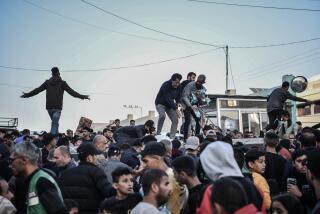IRA Calls Truce in Fight to End British Rule in N. Ireland : Europe: Move could lead to settlement of 25-year conflict, but guerrillas’ statement does not specify if halt to violence is permanent. London officials are cautious.
LONDON — In a major development that could signal an end to one of the world’s oldest conflicts, the Irish Republican Army announced Wednesday a “complete cessation” of violence in its struggle to end British control over Northern Ireland.
“In order to enhance the democratic peace process and underline our definitive commitment to its success, the leadership of (the IRA has) decided that as of midnight Wednesday, Aug. 31, there will be a complete cessation of military operations,” declared a statement issued by the IRA in Dublin, the Irish capital. “All our units have been instructed accordingly.”
The brief statement, issued just before lunchtime here, ended days of mounting speculation that a major breakthrough in the conflict was imminent.
It was immediately hailed by the Irish government and leaders of the Roman Catholic community in Northern Ireland as the end of the 25-year-long guerrilla campaign.
“There’s a deep sense of history in this house today and, indeed, throughout the country,” Irish Prime Minister Albert Reynolds told a special session of the Irish Parliament after the statement was issued. “It is a day that many had begun to fear they might never see.”
President Clinton, who has quietly nudged the warring parties toward a peace formula since February, also hailed Wednesday’s developments as “a watershed announcement” and said the cease-fire could “mark the beginning of a new era that holds the promise of peace for all the people of Northern Ireland.”
But the omission of specific wording in the IRA statement that the cease-fire would be permanent triggered immediate concern among senior British government officials here, who said more was needed before the peace process could move forward as planned.
Under an accord worked out in December, if the IRA agreed first to give up violence, the British and Irish governments agreed to give Sinn Fein, the IRA political wing, a voice in round-table negotiations that would search for a lasting settlement to the Northern Ireland conflict.
In virtually all their references to the agreement, British officials have stressed the need for an IRA pledge for a permanent end to the violence.
It was also unclear if militant Protestants would carry out their threats to step up their own campaign of violence in the wake of the IRA announcement.
Despite this concern and the British reservations, the IRA announcement is the single biggest step so far toward ending a conflict that has claimed more than 3,000 lives and left another 30,000 wounded in a quarter-century of violence.
Indeed, just hours before the IRA declaration, the dispute claimed its most recent victim, as the outlawed Ulster Volunteer Force kidnaped a 37-year-old Catholic, shot him in the head and dumped his body on a roadside.
The current clashes are merely the latest chapter in a centuries-old saga of violence that has pitted the Roman Catholic Irish nationalist minority against a mainly Protestant majority who see British rule as the lone guarantor of their identity.
While the hostility dates to the early 17th Century, when the first Protestant settlers arrived in Ulster from Scotland, the current struggle has its roots in the IRA’s rejection of the 1920s agreement that gave Ireland independence but left the six northern counties, collectively the province of Ulster, in British hands.
The present chapter of violence began in Londonderry in August, 1969, when Catholics and Protestants rioted.
The killing that has ensued is only the visible aspect of a pervasive fear and misery in which an entire generation has matured: After hearing of Wednesday’s cease-fire announcement, one Belfast resident said she dreamed of being able to leave her front door open again in the summer as she did in the years before 1969.
While there were isolated celebrations in Northern Ireland, the prevailing mood among its 1.5 million residents was one of nervous optimism.
“There’s a lot of suspicion,” said John Derby, a political scientist at the University of Colraine, in a mainly Protestant town. “I think it will be hard for the Unionists (Protestants) to sit down with people who’ve been killing them for the last 25 years.”
Wednesday night, British Prime Minister John Major was seeking assurances about the IRA statement from Sinn Fein leader Gerry Adams that could lead to just such a meeting at the peace table.
“If he were to say tonight, ‘This statement is unambiguous,’ that the violence has ended for good, then within three months we could start talking with Sinn Fein on how to go forward with the peace process,” Major told the British Broadcasting Corp.
Northern Ireland Secretary Patrick Mayhew, when asked if the IRA statement met British demands, answered, “No, I don’t think it’s clear.” But he added that “a very few informal words” of assurances would be enough to start the process.
In a television interview late Wednesday, Adams said he would attempt to get the clarifications.
In return for the cease-fire, Adams also called for a demilitarization of Northern Ireland--a withdrawal of the 18,000 British soldiers stationed there--and a return of the IRA prisoners to Northern Ireland from jails in Britain.
But the absence of any reference to a permanent cease-fire in Wednesday’s announcement fueled existing anger and suspicion among hard-line Protestants in Northern Ireland.
With the kind of hate-fueled logic that has so often prevented progress toward peace among the warring factions in the past, Protestant militants are convinced that anything suggested or offered by the IRA, must, almost by definition, be bad for them. They believe the British and Irish governments must have made secret concessions to get the IRA to agree to a cease-fire.
And celebrations Wednesday by Roman Catholic residents in the Ulster capital of Belfast, who drove through their neighborhoods cheering and waving the Irish flag, only reinforced Protestant convictions that the IRA cease-fire is part of a deal against their interests.
Ian Paisley--the leader of the smaller, more radical of the two Protestant-based political parties in Northern Ireland and a member of the British Parliament--denounced the wording of the IRA statement as “a clever Jesuit expression.”
“The only way for the IRA to prove this cease-fire is permanent is by giving up their killing machine and turning in their Semtex (explosives) stores, their guns, their mortars and their equipment,” he thundered.
James Molyneaux, head of the more moderate of the Ulster Protestant-based parties, was less emotional, but stated: “It’s a cessation of hostilities, that’s all it is. It’s not convincing.”
Wednesday’s cease-fire announcement follows a series of low-profile meetings between Anthony Lake, President Clinton’s national security adviser, and leaders of all potential participants in a negotiated settlement.
Clinton also reportedly personally approved limited visas for Joseph Cahill of the IRA and Patrick Treanor of Sinn Fein, who traveled to the United States on Tuesday to explain the cease-fire arrangement to American groups active in backing the guerrillas financially.
On the question of possible U.S. economic aid to Northern Ireland, a senior White House official said Wednesday, “We’re open-minded but we haven’t committed anything on that.”
Administration officials also said they believe that their behind-the-scenes meetings and letters helped push the IRA toward peace.
A senior official noted that Clinton talked to Major 15 times on the subject in August alone. He said there have been meetings and telephone conversations since Feb. 2.
Times staff writer Norman Kempster in Washington contributed to this report.
* REACTION GUARDED: Local Irish Americans welcome the truce--but warily. B1
Background on the Battle
For more than two decades Irish Republican Army guerrillas have battled to overturn Britain’s 70-year partition of Ireland. Their campaign has been resisted with violence by pro-British extremists determined to stay part of Britain.
THE TOLL
Deaths: 3,168
Explosions: 835
Gunfire/other: 2,333
Related deaths outside Northern Ireland: 250
BRITISH PRESENCE
Troops in Northern Ireland: 18,000
Annual British subsidies to Northern Ireland: 3.4 billion pounds ($5.3 billion)
NORTH VS. SOUTH Northern Ireland Population: 1.5 million Protestant/other: 60% Catholic: 40% Republic of Ireland Population: 3.7 million Protestant/other: 5% Catholic: 95% ***
HISTORY OF DISPUTE
1920-22: Brief war with Britain leads to new Irish state, Republic of Ireland. It is predominantly Roman Catholic. Protestants in Northern Ireland, which is predominantly Protestant, persuade Britain to partition Ireland to save them from domination by Catholics in the Republic of Ireland.
1968-69: Catholic civil rights protests lead to violence. British troops sent.
1972: Brief truce fails.
1975: Truce lasts almost eight months.
1994: IRA agrees to truce.
Sources: Times staff, Associated Press, Reuters, 1991 Census of Population in Northern Ireland
Researched by CHRIS ERSKINE / Los Angeles Times
More to Read
Sign up for Essential California
The most important California stories and recommendations in your inbox every morning.
You may occasionally receive promotional content from the Los Angeles Times.










